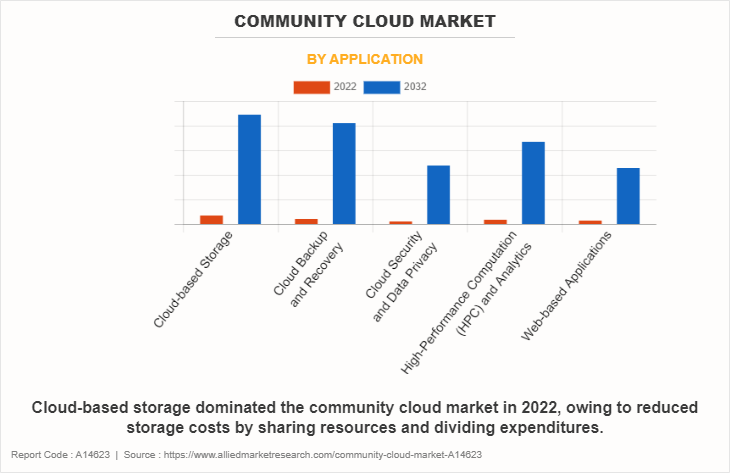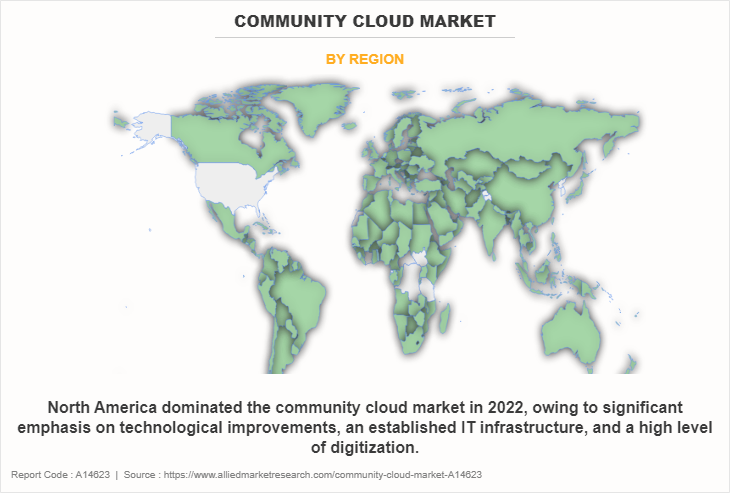Community Cloud Market Insights, 2032
The global community cloud market was valued at $4.7 billion in 2022, and is projected to reach $82.9 billion by 2032, growing at a CAGR of 33.6% from 2023 to 2032.
Rise in demand for infrastructure with high performance and low latency, increase in need to reduce the number of servers and increase green computing, and rise in demand for security, compliance, and data redundancy, primarily drive the growth of the community cloud market. However, governance and trust issues hamper the market growth to some extent. Moreover, rise in collaboration and information exchange between corporations is expected to provide lucrative opportunities for community cloud market forecast.

The community cloud market is a particular area of the cloud computing business that is dedicated to meeting the requirements of a particular community or group of organizations. Community clouds are intended to be shared by a small number of users who have similar needs, requirements, or issues, as opposed to public clouds, which are open to all users. A cost-effective solution that satisfies each community member's unique needs is offered by a community cloud, where infrastructure, resources, and services are shared by all community members. It enables cooperation, data and application sharing, and scale economies among community-based organizations. Community clouds frequently serve industries or areas such as healthcare, government, finance, or education that have particular regulatory or compliance requirements.
Moreover, they offer a safe and secure environment that takes care of issues unique to the sector while also providing advantages of cloud computing, such as scalability, flexibility, and cost-effectiveness. In addition, infrastructure-as-a-service (IaaS), platform-as-a-service (PaaS), and software-as-a-service (SaaS) are a few examples of the vendors and service providers that offer community cloud solutions. These service providers offer specialized solutions made to meet the unique needs and specifications of the community they serve. Furthermore, the need for cooperation and resource sharing among organizations within a particular community, as well as the rise in demand for secure and compliant cloud solutions, are the main factors driving the community cloud market.
The community cloud market is segmented on the basis of component, application, end user, and region. On the basis of component, it is bifurcated into hardware, software, and services. On the basis of application, it is bifurcated into cloud-based storage, cloud backup and recovery, cloud security and data privacy, high performance computing and analytics, and web-based application. On the basis of end user, it is fragmented into BFSI, gaming, healthcare, government, education, and others. On the basis of region, it is analyzed across North America, Europe, Asia-Pacific, and LAMEA.
The global community cloud industry is dominated by key players such as Google LLC, IBM Corporation, Microsoft Corporation, Cisco Systems, Inc., DXC Technology Company, Amazon Web Services, Inc., Broadcom, Atos Se, Akamai Technologies, and VMware, Inc. These players have adopted various strategies to increase their market penetration and strengthen their position in the community cloud industry.

On the basis of application, cloud based storage segment dominated the community cloud market size in 2022 and is expected to maintain its dominance in the upcoming years, owing to reduce storage costs by sharing resources and dividing expenditures propels the market growth significantly. However, the cloud Security and data privacy segment is expected to witness the highest growth, owing to create and provide cutting-edge security solutions, such as encryption, access controls, and threat detection systems, that are precisely suited to the requirements of communities or businesses.

Region-wise, North America dominated the community cloud market share in 2022, owing to significant emphasis on technological improvements, an established IT infrastructure, and a high level of digitization. In addition, advantages of cloud computing, such as cost reductions, scalability, and flexibility, have been acknowledged by businesses in the region. However, Asia-Pacific is expected to be the fastest growing in 2022, owing to rise in demand for scalable and affordable IT solutions. Moreover, the use of community cloud services has increased dramatically in a number of industries, including manufacturing, healthcare, retail, and government.
Top Impacting Factors
Rise in Demand for Infrastructure with High Performance and Low Latency
The efficiency and flexibility of the infrastructure of a company are essential for effective operations and user satisfaction as companies depend on a growing number on cloud-based apps and services. A high-performance infrastructure is required to deliver quickly and efficiently cloud services. By using community cloud, organizations can take advantage of resources and capabilities for large number of people. Performance and responsiveness are enhanced as a result of greater utilization and optimization. In addition, community cloud providers can address the growing demand for fast and dependable cloud services from businesses by offering high-performance infrastructure, thus boosting adoption of community cloud and expansion of the market.
Furthermore, real-time processing applications demand low latency infrastructure. Low latency infrastructure is essential for sectors such as finance, healthcare, and gaming that demand rapidly data processing and transmission. With their close proximity to users and localized infrastructure, community clouds can provide better responsiveness and lower latency than public clouds. Community clouds are resulting in a desirable option for companies, which place high priority on low latency needs. The community cloud market is driven by the need to offer efficient and flexible cloud services to satisfy such requirements as the demand for low latency infrastructure keeps growing.
Increase in Need to Reduce Number of Servers and Increase Green Computing
Community clouds provide a solution that supports businesses' efforts to embrace sustainable practices as they become more aware of their environmental impact. The need for physical servers is reduced as a result of resource sharing and consolidation made possible by community clouds. Community cloud providers can maximize server utilization and minimize the overall hardware footprint by pooling resources and infrastructure. In addition to reducing physical space, this lowers the energy use and carbon emissions produced by running servers. Organizations looking to decrease their environmental impact adhere to the possibility of achieving better server density and efficiency through resource consolidation, which encourages the adoption of community cloud solutions.
By leveraging virtualization and resource optimization strategies, community clouds can encourage a more effective use of resources. Community cloud providers can increase resource utilization and decrease down the requirement for new physical servers by virtualizing server resources. The efficient use of resources is ensured by community clouds using resource optimization strategies such as load balancing and dynamic allocation, which reduce wastage and increase efficiency. Companies that care about the environment, frequently choose community cloud as they offer high priority on resource efficiency and optimization.
Regional Insights
North America
North America dominates the community cloud market due to the region’s advanced IT infrastructure and high adoption rates of cloud technologies across industries. The U.S., in particular, is a major market player, with strong demand from government agencies, healthcare institutions, and financial organizations that require high security and compliance standards. Community cloud solutions in North America are commonly used in regulated industries to ensure data privacy and regulatory compliance. The growing need for secure collaboration and data sharing among public sector organizations and between healthcare providers has been a significant driver in this region.
Europe
Europe is also a significant market for community cloud solutions, driven by the stringent data protection regulations such as the General Data Protection Regulation (GDPR). Countries like Germany, the UK, and France are key players in the region. European governments and public sector organizations are increasingly adopting community cloud solutions to ensure data security and privacy while promoting collaboration across different departments and sectors. The financial services sector is also a major adopter, as community cloud platforms offer a secure environment for data exchange between financial institutions. The European Union’s emphasis on digital sovereignty and the use of cloud technologies to enhance cybersecurity has further boosted the market.
Asia-Pacific
Asia-Pacific is expected to witness the fastest growth in the community cloud market, with countries like China, India, Japan, and South Korea leading the charge. The growing focus on digital transformation in sectors such as healthcare, education, and government is driving the demand for community cloud solutions in this region. In China, the adoption of community cloud solutions is fueled by the need for secure and scalable cloud infrastructure to support government projects and public institutions. India’s growing IT and outsourcing industry is increasingly leveraging community cloud platforms to offer specialized services to sectors that require strict regulatory compliance and data security.
Latin America and Middle East & Africa
In Latin America, countries like Brazil and Mexico are gradually adopting community cloud solutions, especially in government, healthcare, and education sectors. These industries are seeking secure, shared infrastructure to enhance collaboration and cost efficiency. The Middle East & Africa is also seeing growth in community cloud adoption, particularly in the UAE, Saudi Arabia, and South Africa. In these regions, community cloud platforms are being utilized to support smart city projects, digital governance initiatives, and healthcare modernization efforts. The growing focus on cybersecurity and cloud-based solutions for critical sectors is a key driver in these regions.
Key Industry Developments
- March 2024 – Amazon Web Services (AWS) launched a new community cloud initiative specifically tailored for healthcare organizations in North America. The solution enables healthcare providers to securely share data and collaborate on research and development, complying with regulatory standards like HIPAA.
- July 2023 – Salesforce announced its expansion of community cloud offerings to Europe, focusing on the financial services sector. The platform provides secure data sharing for banks and insurance companies across the region, helping them meet GDPR compliance while enhancing customer experience.
- January 2024 – Microsoft Azure partnered with government agencies in India to deploy a community cloud platform designed to facilitate collaboration among different public sector organizations. This initiative supports the Indian government's digital transformation efforts by providing secure cloud services for data sharing across departments.
- August 2023 – IBM introduced its new community cloud platform in Latin America, specifically targeting the healthcare and education sectors. The platform is designed to support collaborative research and learning, allowing institutions to securely share data and resources.
- October 2023 – Google Cloud launched a new community cloud solution in the Middle East, focusing on the UAE's growing smart city initiatives. The platform offers a shared infrastructure for various government departments to collaborate on urban planning and digital governance projects securely.
Key Benefits for Stakeholders
- This report provides a quantitative analysis of the market segments, current trends, estimations, and dynamics of the community cloud market analysis from 2022 to 2032 to identify the prevailing community cloud market opportunities.
- The market research is offered along with information related to key drivers, restraints, and opportunities.
- Porter's five forces analysis highlights the potency of buyers and suppliers to enable stakeholders make profit-oriented business decisions and strengthen their supplier-buyer network.
- In-depth analysis of the community cloud market segmentation assists to determine the prevailing market opportunities.
- Major countries in each region are mapped according to their revenue contribution to the global community cloud market growth.
- Market player positioning facilitates benchmarking and provides a clear understanding of the present position of the market players.
- The report includes the analysis of the regional as well as global community cloud market trends, key players, market segments, application areas, and market growth strategies.
Community Cloud Market Report Highlights
| Aspects | Details |
| Market Size By 2032 | USD 82.9 billion |
| Growth Rate | CAGR of 33.6% |
| Forecast period | 2022 - 2032 |
| Report Pages | 310 |
| By Component |
|
| By Application |
|
| By End User |
|
| By Region |
|
| Key Market Players | Amazon Web Services, Inc., DXC Technology Company, Broadcom, VMware, Inc., Google LLC, Akamai Technologies, Atos SE, Cisco Systems, Inc., Microsoft Corporation, IBM Corporation |
Analyst Review
A fast expanding market within the cloud computing sector, the community cloud market has been aimed at addressing the requirements of particular communities or groupings of organizations. Community clouds, as opposed to public clouds, are intended to be used collaboratively by a small number of users who share the same needs, requirements, or concerns. The necessity for resource sharing and collaboration among organizations operating within a particular community, as well as rise in demand for secure and compliant cloud solutions, are the main factors driving the growth of the market. Community clouds are particularly appealing to industries or sectors with unique regulatory or compliance needs, such as healthcare, government, banking, or education. In addition, small- and medium-sized organizations prefer the community cloud model as compared to the typical cloud technology strategy to generate profits and achieve economies of scale quickly. Moreover, the demand for high-performance, low-latency infrastructure on a global scale drives the community cloud technologies market. The adoption of community cloud technology is also motivated by the need to achieve economies of scale through the use of a shared pricing model, shared concerns for data redundancy, security, and compliance, and a push towards green computing to reduce the number of servers. Furthermore, security concerns over corporate data in a shared environment is a barrier to the market growth. The government's measures to encourage the use of community cloud technology in public and private sectors, and the investments made in cloud technology by the research and educational sectors, are anticipated to fuel the market expansion in the upcoming years.?
For instance, in February 2023, IBM collaborated with Wasabi Technologies, the cloud storage company, to drive data innovation across hybrid cloud environments. This collaboration aims to allow enterprises to run applications across any environment on-premises, in the cloud or at the edge and help enable users to cost efficiently access and utilize key business data and analytics in real time. The Boston Red Sox be the first to leverage the power of IBM Cloud Satellite® and Wasabi cloud storage, designed to improve the club's operation across its entire business.
The community cloud market was valued at $4,691.63 million in 2022 and is estimated to reach $82,905.80 million by 2032, exhibiting a CAGR of 33.6% from 2023 to 2032.
North America is the largest regional market for Community Cloud
The global community cloud industry is dominated by key players such as Google LLC, IBM Corporation, Microsoft Corporation, Cisco Systems, Inc., DXC Technology Company, Amazon Web Services, Inc., Broadcom, Atos Se, Akamai Technologies, and VMware, Inc. These players have adopted various strategies to increase their market penetration and strengthen their position in the community cloud market.
Rise in collaboration and information exchange between corporations is the leading application of Community Cloud Market
Rise in demand for infrastructure with high performance increase in need to reduce the number of servers and increase green computing are the upcoming trends of Community Cloud Market in the world
Loading Table Of Content...
Loading Research Methodology...


